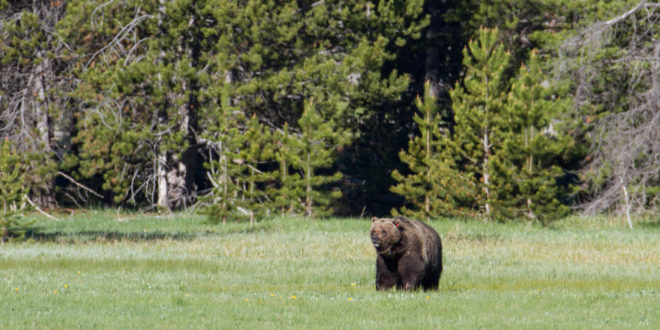Conservation and animal advocacy groups are alleging that Montana and Wyoming agreed to share some of their grizzly hunt quotas.
Specifically, the groups allege Montana shared some of its allocation with Wyoming so the latter state could have a larger hunting quota this fall.
Officials with Montana Fish, Wildlife & Parks and the Wyoming Game and Fish Department have pushed back against the allegations.
According to the Associated Press, Center for Biological Diversity attorney Andrea Santarsiere alleges Wyoming officials told the audience of an April 12 meeting on grizzly hunting that Montana had agreed to share some of its grizzly allocation so Wyoming could round up its number.
According to the AP, the claim was reportedly repeated at other meetings.
Since assuming management of Yellowstone area grizzly bears in August 2017, the agencies have struck up an interstate agreement regarding the number of bears in the “demographic monitoring area,” which encompasses the Greater Yellowstone Area. Using a formula, states split grizzly hunting quotas three ways, with some states getting more based on the number grizzlies estimated to live there.
According to the AP, Wyoming’s quota allocated 1.45 females and 9.86 males. However, under the state’s draft hunting regulations, the state has called for hunting two females and 10 males in the DMA. The state has also proposed hunting 12 grizzlies outside the DMA.
According to the Missoulian, Montana was allocated 0.9 female and 5.8 males, while Idaho was allocated 0.1 females and 0.9 males. Idaho Fish and Game has proposed a season on one male grizzly, while Montana has declined to host a hunting season this year.
The Missoulian adds that April 24, the Center—along with the Humane Society, Sierra Club, Natural Resources Defense Council, Grizzly Times, Wyoming Untrapped and Wyoming Wildlife Advocates—addressed a letter to Montana FWP Director Martha Williams decrying the alleged swap.
Montana FWP spokesman Greg Lemon told the AP no agreement to swap grizzly quotas had been made. Meanwhile, Dan Thompson, large carnivore supervisor with Wyoming Game and Fish, told the AP that if he said such a swap had been made, then he spoke in error, a claim reiterated in the Jackson Hole News & Guide.
“I’ll take full credit for saying some wrong word, such as transfer,” Thompson told the Guide. “At the tristate meeting, we all agreed that rounding was OK as long as it didn’t result in an increase in the overall allocation. We didn’t agree to take their allocation.”
According to the Missoulian, Lemon said that, at a series of January and February meetings, the agencies had discussed rounding as a means of dealing with “fractional mortality”—since you can’t hunt 1.45 bears—and that the state of Montana would retain its mortality count and not share any of its grizzly allocation.
The fate of Wyoming and Idaho’s hunting seasons are currently uncertain, owing to ongoing litigation and deliberation within the U.S. Fish and Wildlife Service.
After the USFWS delisted Yellowstone area grizzly bears from the Endangered Species List in June 2017, multiple conservation, environmental and animal advocacy groups sued the agency, arguing that the decision was premature and not founded on sound science. Those separate suits have since been consolidated. A hearing on the suit is scheduled for August 2018, just ahead of Wyoming and Idaho’s proposed hunting seasons.
Meanwhile, following a ruling against the agency in December over its handling of Great Lakes wolves, the USFWS announced it would revisit its grizzly decision and solicit public comment on the matter. A decision on whether Yellowstone area grizzly bears will regain endangered species status or not is still forthcoming.
Grizzly bears once roamed much of the American West and Canada, but are today mostly live in biogeographic “islands” bounded by civilization. Besides curtailing hunting, grizzly advocates have pushed for establishing “connectivity” between remote populations.
Recent research, for instance, has charted possible pathways for Yellowstone grizzlies to reunite with bears in the Northern Continental Divide Ecosystem in northwestern Montana.
This article has been updated with additional information.
 Yellowstone Insider Your Complete Guide to America's First National Park
Yellowstone Insider Your Complete Guide to America's First National Park





